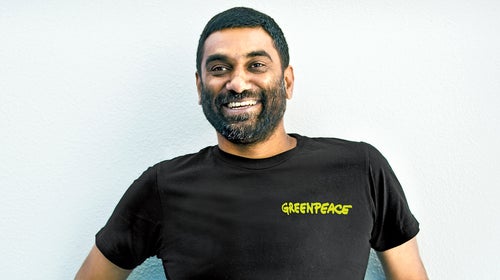This Man Is Greenpeace’s Best Hope
Human-rights superhero Kumi Naidoo has a tough assignment: lead the organization into 21st-century relevance. But after a year that saw activists lionized (imprisoned in Putin's jails) and then vilified (unfurling a banner on Peru's ancient Nazca lines), can he save the day?
New perk: Easily find new routes and hidden gems, upcoming running events, and more near you. Your weekly Local Running Newsletter has everything you need to lace up! .
A Romanian, a German, and a South African hailed a cab. It was around 11 p.m. on a cool night last September in Manhattan, and the men were planning to make a video.ŌĆ© They all worked for Greenpeace, the international environmental nonprofit, but had little in common besides that. The Romanian was , a 33-year-old communications specialist whoŌĆÖd joined Greenpeace after burning out on a D.C. desk job and spending a couple of years working to protect mountain gorillas in the Congo. The German, 46-year-old Wolfgang Sadik, was a lifer; heŌĆÖd been with the organization for 25 years. He helped run the actions team, the cloak-and-dagger unit that does the planning when, say, an oil rig needs scaling. The South African was the boss, Greenpeace International executive director . A tall, lanky, former human-rights activist with a kind manner, a gray-flecked beard, and an ever present African shirt, 50-year-old Naidoo is the organizationŌĆÖs public face.
The men were in New York City for the , a meeting of 100 heads of state billed as the next major stage in international efforts to tackle global warming. Naidoo was excited about the previous dayŌĆÖs march, in which nearly 400,000 people filled the streets of Manhattan, but no one was particularly optimistic about the UN gathering itself. Earlier that day, appearing on a panel at the 92nd Street Y with founder and rockers turned activists Linkin Park, Naidoo had called it ŌĆ£verbal masturbation.ŌĆØ
So he, Dumitrascu, Sadik, and a few others were going to apply pressure. The plan was to shoot a short social-media video of Naidoo calling for governments to enact clean-energy policy and, as he intoned in his deep baritone, ŌĆ£Listen to the people, not the polluters!ŌĆØ Later, at about 3 a.m., Sadik and a team would project that phrase onto one face of the UN building, on ManhattanŌĆÖs East Side, in several languages. The stunt was illegal but not dangerous, so Naidoo had only just been told the day before.
ŌĆ£The actions are often done on a need-to-know basis,ŌĆØ he told me as the cab rolled along. ŌĆ£Most actions, I wonŌĆÖt be consulted about it. But if itŌĆÖs something where it could be prison time or a very big court case, then theyŌĆÖll come to me and say, ŌĆśWe are doing this action, it requires so much of the activists, the legal assessment is this, the worst-case scenario is this.ŌĆÖ And IŌĆÖve never said no. Because our people are competent.ŌĆØ
[quote]ŌĆ£The way I see it,ŌĆØ Naidoo says, ŌĆ£addressing climate change is more important than all the injustices weŌĆÖve fought over time put together. Colonialism, slavery, apartheid. This is about survivalŌĆŗ.ŌĆŗŌĆØ[/quote]
Naidoo is GreenpeaceŌĆÖs great hope. He spent his teenage years fighting apartheid in South Africa, buried too many friends, went into exile, and later rose to prominence in the international human-rights world. Greenpeace , when the organization was having what could gently be called a crisis of relevance. At one time the most powerful direct-action group on earth, it was trapped in a frustrating phase. With about 2,500 employees spread across 41 offices around the world, Greenpeace was too big to play the underdog, but it was still weighed down by institutional nostalgia for its scrappy no-nukes days. Since taking over in 2009, Naidoo has driven an ambitious plan to turn Greenpeace from a top-down, European NGOŌĆöits headquarters are in AmsterdamŌĆöto a decentralized, quasi-guerrilla outfit with a powerful presence in the places where, he believes, the climate war will be won or lost: Africa, Asia, and South America.
We hopped out at 41st Street, where three more members of the team waited by a balcony overlooking the East River. As a cameraman prepped Naidoo, I walked off to the side with Sadik. He had a big, well-coiffed sweep of silver hair, a mustache and soul patch, and large, probing eyes. He told me that when he was 16, his buddies wanted to join a protest against a power plant, but his father, who didnŌĆÖt like hippies or radicals, said he couldnŌĆÖt go. So he went. ŌĆ£It was wintertime, and I came at night to a secret group in the forest,ŌĆØ Sadik recalled. ŌĆ£They said, ŌĆśWe are with Greenpeace.ŌĆÖŌĆēŌĆØ He knew then what he needed to do with his life. ŌĆ£I wanted to feel politics with my senses,ŌĆØ he told me. ŌĆ£ThatŌĆÖs why I always specialized in actions.ŌĆØ Sadik did graduate work in archaeology at the University of Vienna but later came back to the Greenpeace fold. ŌĆ£Now,ŌĆØ he said, ŌĆ£IŌĆÖm saving future and past.ŌĆØ
Naidoo finished speaking to the camera and began walking back to his hotel, leaving Sadik and the team to deal with the projection. As I watched all this, I was struck by an obvious flaw in the plan: Who would be walking by the UN at 3 a.m.? The whole thing seemed quaint and also kind of funny.
That is, it seemed funny until two months later, when an action in Peru backfired spectacularly and Naidoo was desperately trying to save GreenpeaceŌĆÖs reputation after the worst gaffe in its 43-year history. At that point, I thought back to the last thing heŌĆÖd said that night in New York, an offhand joke as he walked away: ŌĆ£DonŌĆÖt wake me up if you get arrested!ŌĆØ
HereŌĆÖs what happened: In early December, a group of 20 Greenpeace activists from seven countries, including Argentina, Chile, and Germany, traveled about six hours south from Lima. Argentine Associated Press photographer Rodrigo Abd and Herbert Villarraga, a Colombian videographer for Reuters, accompanied them. They had all come to Peru for , a multinational climate conference designed to pave the way for a binding agreement on carbon emissions, and they had secretly planned an action.
Their destination was the Nazca Lines, one of PeruŌĆÖs most sacred sites. Starting around 500 B.C., the Nazca people, who lived in a nearby river valley, created hundreds of giant geoglyphsŌĆötrapezoids, a dog, a hummingbird, a pelican more than 900 feet longŌĆöby removing reddish brown surface rocks to expose the light soil beneath. Some scholars think they were religious symbols; others believe they were used to chart the seasons. The Nazca themselves were gone by 750 A.D., seemingly done in by vicious El Ni├▒o flooding exacerbated by their own agricultural clear-cutting. But because the Nazca Desert receives little rain and less wind, the lines have survived. A Unesco World Heritage site, they are a popular fly-over destination for tourists and aerial photographers. The hummingbird graces one of PeruŌĆÖs most common coins.
In the predawn hours of December 8, the activists walked about half a mile from a dirt road to one of the most easily accessible symbols, the hummingbird. They carried backpacks, coolers of water, and a drone. As the sun rose, they spelling out
TIME
FOR CHANGE!
THE FUTURE IS RENEWABLE
GREENPEACE
under the birdŌĆÖs beak. According to a published a week after the incident, one activist, who appeared to be running things, told the others to be careful not to step on the lines. The story identified him as Wolfgang Sadik. In a , Sadik says, ŌĆ£We chose the Nazca Lines because we think that these lines are a symbol of climate change. What happened here in the past on a smaller scale happens now on a global scale, and the Nazca culture disappeared because of climate change.ŌĆØ
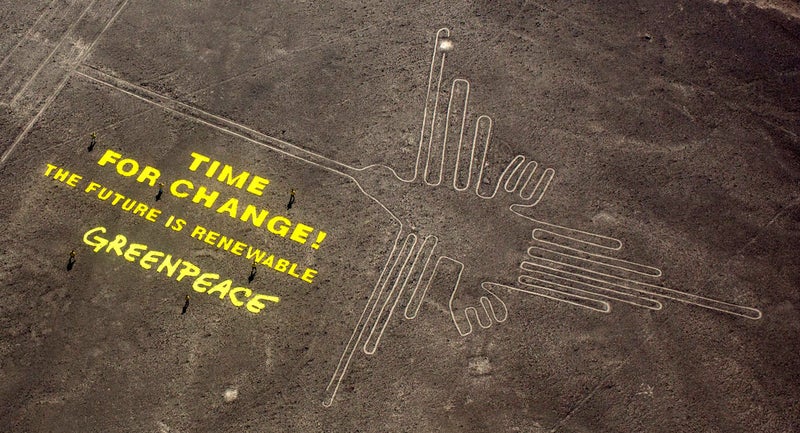
The previous day, Greenpeace activists had posted footage of a similar message created at Machu Picchu. But Nazca is a more vulnerable place, and the moment the images went up on Twitter, the public attacked. Conservative media in Peru denounced the act as a violation of cultural heritage, and news outlets from the BBC to NBC followed. The activists had committed a grave insult by entering the site, which is off-limits to visitors without a guide and special footwear. Worse, the offenders left marks in the soilŌĆötheir tracks and an imprint of the letter CŌĆöthat, Peruvian officials allege, canŌĆÖt be erased.
The day after the action, the Nazca branch of La Fiscalia, PeruŌĆÖs federal prosecuting office, opened a preliminary investigation, a precursor to formal charges. But all 20 activists had left the country before any travel restrictions were put in place. Greenpeace went into damage control. The top brass claimed they had no advance knowledge of the action, and spokespeople issued anodyne apologies, including an understatement of the year: ŌĆ£.ŌĆØ Greenpeace refused to release the activistsŌĆÖ names, a radical departure for an organization built on claiming credit for civil disobedience.
Like the rest of the leadership, Naidoo claimed ignorance. On December 8, he was in the Philippines, delivering solar chargers to victims of Typhoon Hagupit. That morning, before the uproar, his Twitter account retweeted an image of the Nazca stunt to his 30,000 followers, but Naidoo says he wasnŌĆÖt behind the tweetŌĆöGreenpeaceŌĆÖs communications department helps manage his feed. Naidoo says he first heard what happened on his way to the airport in Manila to board a flight to Amsterdam. When the plane landed, his voice mail was full. He slept for six hours, then booked a flight to Lima. He arrived to find news teams waiting.
ŌĆ£This is not what we stand for,ŌĆØ he . ŌĆ£This is not what I stand for.ŌĆØ When he walked out of a Nazca court after a preliminary hearing the following week, people threw eggs. ŌĆ£Watch out at the Taj Mahal, watch out at the pyramids in Egypt,ŌĆØ . ŌĆ£Because we all face the threat that Greenpeace could attack any of humanityŌĆÖs historical heritage.ŌĆØ The groupŌĆÖs Facebook page filled with profane invective. Canvassers in the U.S. were harassed. ŌĆ£In 35 years of activism,ŌĆØ Naidoo told me, ŌĆ£there has never been a moment when IŌĆÖve felt so ashamed.ŌĆØ
The Nazca fiasco was raw meat for the large segment of the public that tends to think of environmentalists in generalŌĆöand Greenpeace specificallyŌĆöas strident or out of touch. It also surprised many, because Greenpeace has undergone a profound shift under NaidooŌĆÖs leadership. Before he was hired, the group was seen by many as too stunt oriented, northern (read: white and a little naive), hungry for credit, and smugŌĆöin short, the kind of outfit that might have unfurled a dumb slogan at the Nazca Lines. But in the past five years, Greenpeace dramatically increased its standing among environmental and business leaders alike by making a shrewd double move.
Most visibly, it has returned to classic, bold direct action. At the same time, it has reinvented itself as a pragmatic, behind-the-scenes organization that can dramatically influence large corporationsŌĆÖ global supply chains, convincing companies like Coca-Cola, for example, to . Last October, two months before Nazca, I spoke with , CEO of the , who said, ŌĆ£Under KumiŌĆÖs leadership, Greenpeace is less focused on flamboyant campaigns and more focused on getting things accomplished in the field.ŌĆØ
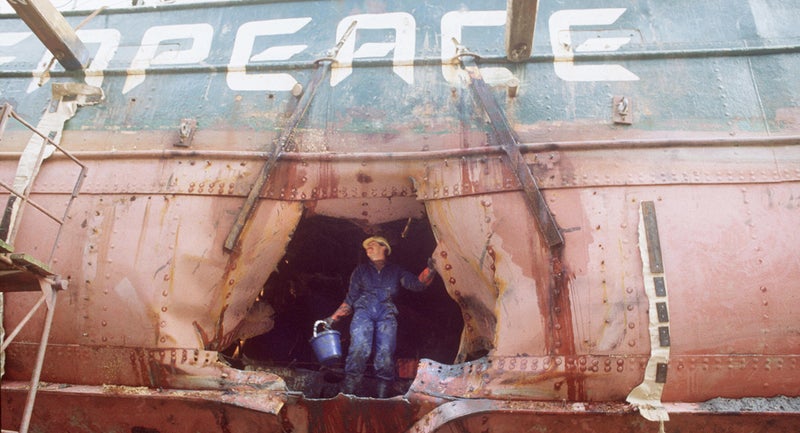
Greenpeace was built on flamboyance. The organization was founded in 1972 in Vancouver, British Columbia, by would-be revolutionaries who called themselves ŌĆ£hobbits.ŌĆØ The year before, when the U.S. government had planned a nuclear-bomb test at the Aleutian island of Amchitka, 11 protestors . They didnŌĆÖt stop the test, but they did launch a movement that would endure. Greenpeace picked and won big fights by relying on a simple formula: find someone harming the environment, confront them with cameras rolling, and use publicity to generate outrage. There were bumps along the wayŌĆönotably, the 1985 by French foreign-intelligence operatives in New ZealandŌĆöbut during its first two decades, Greenpeace was arguably the most effective activist operation in history. It created a generation of antiwhaling and antinuclear activists, and gave donor-funded antiestablishment environmentalism a face.
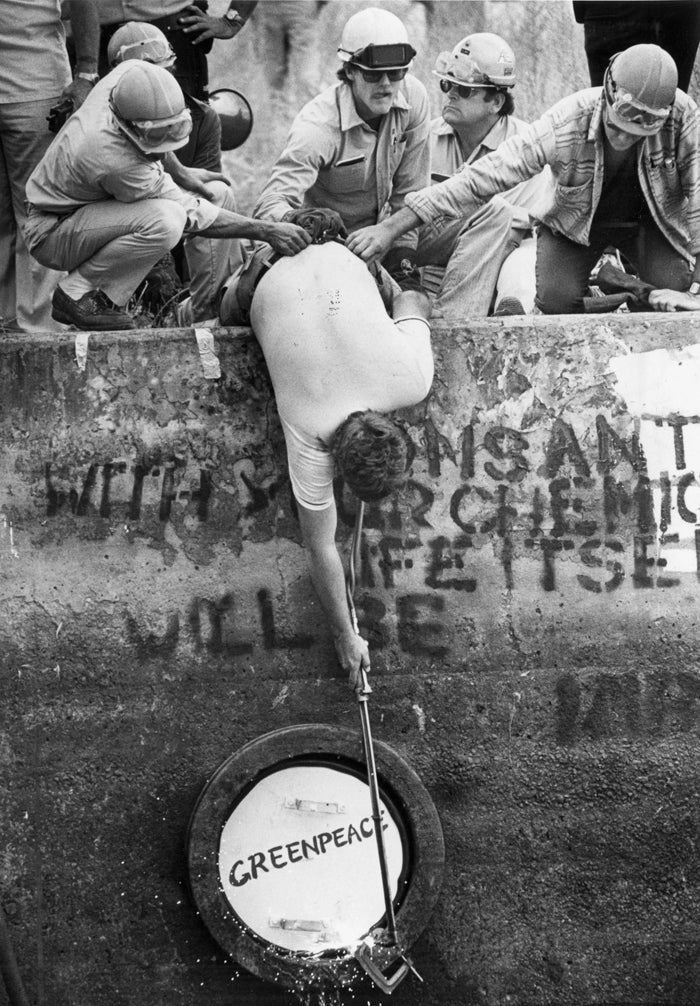
Starting in the nineties, Greenpeace tried to paint itself as a policy influencer, ceding direct fights to groups like and . Sea ShepherdŌĆÖs leader, , a Greenpeace cofounder turned vociferous critic, has become a household name, thanks to Whale Wars, the popular reality-TV series about direct action against Japanese whalers. Around 2005, Greenpeace started targeting corporations, taking on companies like McDonaldŌĆÖs over . Still, its influence waned; it was too extremist for corporations and not tough enough for other environmentalists.
Naidoo was hired to perform a brand rescue. He focused on a few key climate issues, like Arctic oil drilling and deforestation in Asia and the Amazon. He also pushed for an ambitious restructuring to move people and money away from traditional European environmental strongholds to places like China, Brazil, and India.
The shift south and east has caused some turmoil in the ranks, but it has also been seen as forward-thinking as other NGOs make similar moves. ŌĆ£All of us big international organizations that have our roots in North America and Europe have to change,ŌĆØ says Samantha Smith, director of global climate and energy initiatives at the . ŌĆ£WeŌĆÖre not winning the fights we need to win. If you canŌĆÖt credibly speak to the concerns of developing countries about getting people out of poverty while also getting off coal, youŌĆÖre not going to be effective.ŌĆØ
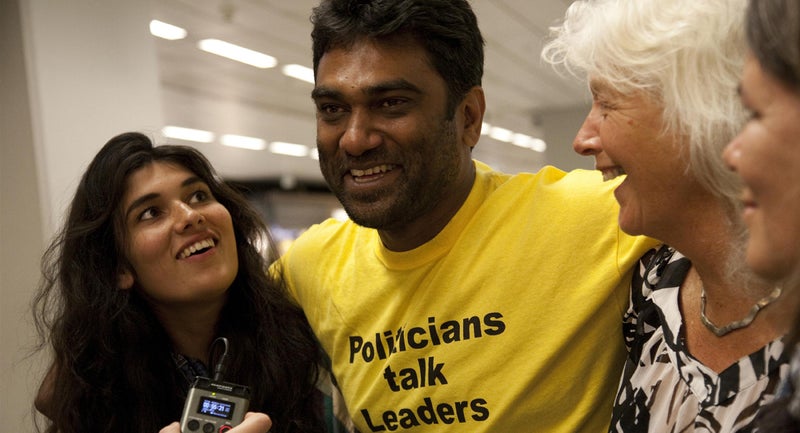
But itŌĆÖs the return to civil disobedience that has raised GreenpeaceŌĆÖs public profile the most. In 2011, Naidoo when he scaled an oil rig off the coast of Greenland. Two years later, in September 2013, 28 Greenpeace activists protesting Arctic drilling, along with a photographer and videographer, were off the Russian coast. Some of the group were climbing an oil platform when a helicopter materialized overhead, dropping balaclava-clad Russian troops armed with machine guns onto the deck of their icebreaker, the Arctic Sunrise. The activists were charged with piracy (later lessened to hooliganism) and threatened with 15 years in prison. For nearly three months, the so-called languished in primitive, freezing jails. Naidoo offered to trade places with them, and 11 Nobel Prize winners wrote to Russian president Vladimir Putin, asking that the charges be dropped. German chancellor Angela Merkel and New Zealand prime minister John Key chimed in, and even Watson had to praise his old outfit. ŌĆ£It appears that Greenpeace has sparked a new cold war,ŌĆØ he wrote on his Facebook page. Nearly four months after the arrest, on the eve of the Sochi Olympics, Russia . Greenpeace, it seemed, was back.
On the surface, Greenpeace and Naidoo arenŌĆÖt an obvious match. He grew up in a poor township outside Durban, the second of four children in a family descended from Indian indentured servants. But Kumi and his siblings never felt poor, even when they attended an elementary school that lacked electricity. His mother, Mana, sewed clothing for neighbors, and his father, Shunmugam, was a bookkeeper. ŌĆ£We have enough,ŌĆØ Mana would tell the kids. A picture of Mahatma Gandhi hung on a wall in the family home.
In June of 1976, when Kumi was ten, thousands of black students gathered in SowetoŌĆöthe famous township near JohannesburgŌĆöto protest the governmentŌĆÖs decree that Afrikaans would be a compulsory language in public schools. Police opened fire, killing hundreds. The Naidoo kids were only vaguely aware of the violence. ŌĆ£I clearly remember our teachers telling us we were privileged because we were top students, and we would get out of the township,ŌĆØ says KumiŌĆÖs younger brother, Kovin, now a leading optometrist in South Africa.
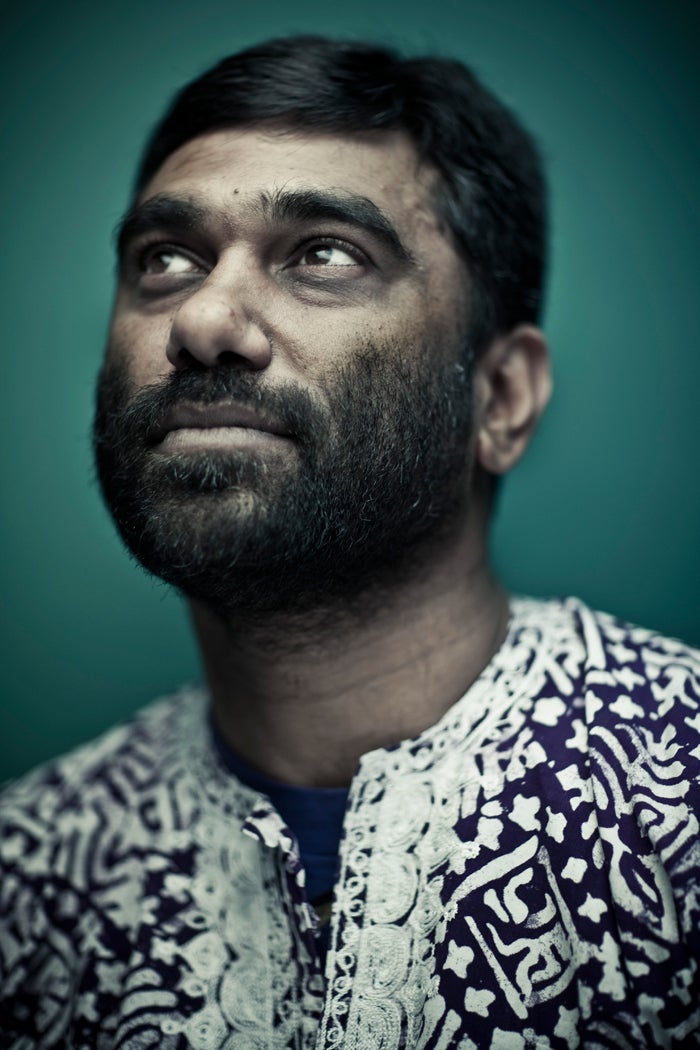
In 1980, this optimism crashed down in a sudden stroke when Mana committed suicide. Kumi, who was 15, briefly sought refuge in alcohol, getting tanked and falling asleep on park benches. Then he and Kovin threw themselves into the student protest movement, taking part in dangerous clashes with police. Kumi has often asked himself whether his motherŌĆÖs death pushed him to the front lines. ŌĆ£If she had been alive,ŌĆØ he says, ŌĆ£would I have had the courage? I always wonder.ŌĆØ
Kumi and Kovin were expelled from high school for their roles in the marches. The principal called Shunmugam and told him to pick up his sons. Shunmugam replied that the boys could walk and hung up. Shortly after that, sensing the potential for more trouble, he took the boysŌĆÖ passports and hid them.
In 1983, Kumi enrolled at the University of Durban-Westville, where he studied politics. He and Kovin soon joined the ŌĆöan illegal act, since the party had been forced undergroundŌĆöworking in different cells. Kumi helped lead the ANCŌĆÖs student group and also organized for the armed revolutionary branch, recruiting and distributing illegal literature. He told me he never took part in any violence, an assertion that a half-dozen sources in South Africa back up. ŌĆ£I was so high-profile in the mass movement,ŌĆØ he says. ŌĆ£They were bugging our phone. So I was never put under pressure to join the armed struggle.ŌĆØ
Still, Naidoo says, it was a different time with a different moral code, and he spent most of his weekends at the funerals of friends killed by police. In December 1986, he was awarded a Rhodes scholarship to study political philosophy at Oxford University. By then, however, NaidooŌĆÖs ANC cell had been compromised and he was on the run, hiding in friendsŌĆÖ houses. Soon after the Rhodes news, the police came to his dadŌĆÖs house late at night, threatening to kill Kumi if they caught him. Another night, he snuck back home and Shunmugam gave him his passport. The next spring, to avoid a court summons that he was convinced would lead to his imprisonment and torture, he had some doctor friends admit him to a hospital, where they administered a placebo IV. He was discharged just before the court sent police racing over.
But before Naidoo could flee to England, he still had to take his exams. So he asked a friend, prominent playwright Ronnie Govender, to design a disguise. ŌĆ£He said, ŌĆśWeŌĆÖre going with the Lionel Richie,ŌĆÖŌĆēŌĆØ Naidoo recalls. The young activist got a perm, shaved his beard, and walked around unmolested while finishing his exams with the help of a sympathetic professor. Close friends couldnŌĆÖt recognize him. He made it to England and was just a year into his Ph.D. studies, in June 1988, when Kovin was arrested and thrown into solitary confinement for eight months.
In 1990, the ANC was unbanned and Nelson Mandela was released from prison. Naidoo returned to South Africa to help establish the ANC as a legitimate party, then trained electoral staff for the countryŌĆÖs first democratic election, in 1994, when Mandela became president. It wasnŌĆÖt long before he saw his comrades taking lucrative jobs or entering politics. ŌĆ£People like me became marketable,ŌĆØ he says. ŌĆ£I jokingly said the term NGO no longer stands for nongovernmental organization, but next governmental official.ŌĆØ
He founded an umbrella group for South African NGOs, then joined , a small human-rights organization that punched way above its weight. He soon found himself fielding invites to talk at venues like the World Economic Forum, in Davos. His many fans from the international NGO circuit point to one standout trait: his humility. ŌĆ£When he comes in and speaks, heŌĆÖs speaking on behalf of a lot of people,ŌĆØ says Cynthia Ryan, a trustee of the , which funds human-rights and security initiatives. ŌĆ£HeŌĆÖs very aware of that.ŌĆØ
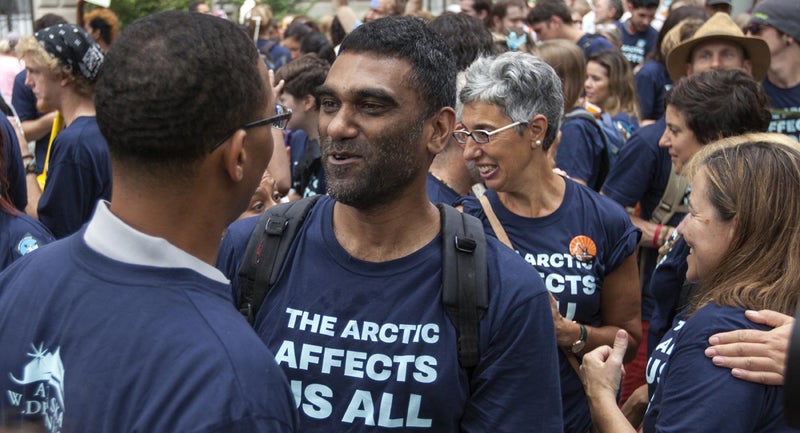
Naidoo started tuning in to environmental issues in part through his daughter, Naomi. (He has never married; NaomiŌĆÖs mother is a friend from Oxford.) In 2008, he joined Greenpeace Africa as a board member. In 2009, , the chairman of GreenpeaceŌĆÖs board, called. At the time, environmental NGOs were starting to look south and east while moving away from nature-centric strategies and toward a vision that accounted for human wellbeing. Greenpeace, meanwhile, was caught largely in the past. ŌĆ£They needed to bring relevance to an organization that many saw as increasingly irrelevant,ŌĆØ says , executive vice president of . But Naidoo was 19 days into a hunger strike to protest the humanitarian crisis in Zimbabwe.
ŌĆ£Thank you very much,ŌĆØ he said. ŌĆ£But IŌĆÖm afraid itŌĆÖs bad timing.ŌĆØ
That night he spoke about it with Naomi. ŌĆ£Dad,ŌĆØ she said, ŌĆ£if you donŌĆÖt consider this, IŌĆÖll never speak to you again.ŌĆØ
So he took the job.
Greenpeace has an annual budget of about $330 million, all of which comes from individual donors or foundations; it doesnŌĆÖt accept corporate contributions. ThatŌĆÖs roughly $200 million more than Conservation InternationalŌĆÖs annual operating cost, but $300 million less than the World Wildlife FundŌĆÖs and $400 million less than the Nature ConservancyŌĆÖs. Naidoo doesnŌĆÖt wield the influence that the Nature ConservancyŌĆÖs Tercek or Conservation International CEO Peter Seligmann do. He canŌĆÖt preserve small Edens with the stroke of a pen. His compensation is also lower: Naidoo makes about $150,000ŌĆöaround a quarter of what Tercek does.
But GreenpeaceŌĆÖs resources are used in a way that gives Naidoo a singular power, one that is particularly scary if youŌĆÖre the CEO of a multinational corporation. Greenpeace spends about $100 million a year on campaigns and media outreach, much of which is aimed at attacking specific brands. These days it pays to be seen as a Greenpeace allyŌĆöor, more specifically, to avoid being seen as a Greenpeace foe.
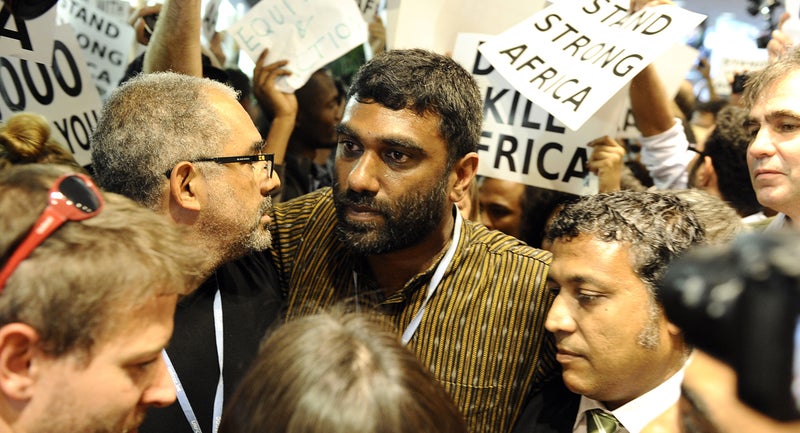
I saw this firsthand at the climate summit in New York, where executives from Asia Pulp and Paper pulled Naidoo aside for a photo op. In 2011, Greenpeace targeted the toy company Mattel over its use of packaging from APP, which was clear-cutting Indonesian rainforests. It first tried to convince Mattel to change its supply chain. When Mattel didnŌĆÖt, GreenpeaceŌĆÖs social-media team in which Barbie gets dumped by Ken. In the spot, an unnamed whistle-blower shows Ken a video of Barbie chainsawing orangutan habitat. Ken yells, ŌĆ£ItŌĆÖs over! That fucking bitch!ŌĆØ After receiving 500,000 e-mails, Mattel dropped APP.
Other successful campaigns have targeted Nestl├®, for its , and Facebook, for its . (The latter campaign was coordinated on Facebook.) Last year, Greenpeace for its reported $116 million partnership with Shell, the Arctic-dreaming oil giant. Lego resisted an initial protest, in which Greenpeace activists dressed as Lego figures showed up at the companyŌĆÖs flagship store in New York City. But in July, a video showing toy figures drowning in oil went viral. Six million people read the words ŌĆ£Shell is poisoning our kidsŌĆÖ imaginations.ŌĆØ As a result, Lego agreed to stop selling Shell-branded toy race cars.
Business executives I spoke with portrayed Naidoo as a shrewd, pragmatic negotiator who would rather implement change behind the scenes than twist a public knife. ŌĆ£HeŌĆÖs not an extremist,ŌĆØ says Paul Polman, CEO of Unilever, which was persuaded by Greenpeace to ditch hydrofluorocarbons, a greenhouse gas used in refrigerants. ŌĆ£ItŌĆÖs not always GreenpeaceŌĆÖs way or the highway. It helps with these discussions to take the emotion out of it, and Kumi should be credited with that.ŌĆØ
To Sea ShepherdŌĆÖs Paul Watson, this is called selling out. ŌĆ£TheyŌĆÖre a multinational eco-business,ŌĆØ he likes to say. ŌĆ£The have a ship that goes around fundraising, and they make money from peopleŌĆÖs genuine concern.ŌĆØ He also told me, ŌĆ£KumiŌĆÖs not really an environmentalist. He came from a human-rights background. What did change since Kumi came in is that Greenpeace isnŌĆÖt doing as many campaigns.ŌĆØ
Greenpeace would readily agree that its focus is increasingly multinational. The plan for the shift to developing countriesŌĆöthe ŌĆ£new operating model,ŌĆØ as itŌĆÖs called internallyŌĆöwas first raised by NaidooŌĆÖs predecessor, a German scientist named Gerd Leipold. But Naidoo, who is at heart a community organizer, has made it a defining cause.
ŌĆ£We donŌĆÖt win if we donŌĆÖt win in the countries with significant population sizes in the global south,ŌĆØ says Naidoo. ŌĆ£Even if everyone else says, ŌĆśWeŌĆÖll do the right thing,ŌĆÖ if China, Brazil, African countries, and India go for a carbon-intensive economy, we will lose.ŌĆØ
Under the system, scheduled to be finalized by the end of the year, all 40 of GreenpeaceŌĆÖs national chapters will pool their funds. Areas like Asia, Africa, Brazil, and the U.S. (important because of its energy consumption) will receive the lionŌĆÖs share of the money, while big fundraising countries like Germany and the Netherlands will sacrifice. Nearly 70 of the 250 jobs in Amsterdam will move overseas, a process thatŌĆÖs already begun.
Campaigns in the global south and east take many forms. Some are feel-good, like the 2010 effort to in rural South Africa so people could watch the World Cup. Some are contentious: last year, the Indian government and arrested two of its activists in a heated battle over a proposed coal mine. Some are still fuzzy: in China, where civil disobedience is about as welcome as Free Tibet stickers, Greenpeace has focused on legal campaigns and awareness-raising artŌĆö and a powerful about smog by a Chinese director. Some can be dangerous: in 2010, in Indonesia, and someone hung an effigy of Naidoo outside the Jakarta office in 2012.
And some are pretty boring: in Cameroon, Greenpeace has about a New York agriculture firm that wants to clear forests to produce palm oil. The idea is not to claim credit but to educate locals so theyŌĆÖre better prepared next time. ŌĆ£Kumi is encouraging people to look at issues more systemically,ŌĆØ says , the U.S. director. ŌĆ£The environment is deeply connected to all these other issues: economic injustice, racism, problems with neoliberal economies. That is a deeper analysis than ŌĆśYou have to save the forests,ŌĆÖ and I appreciate that.ŌĆØ
Another U.S. staffer put it more succinctly: ŌĆ£HeŌĆÖs helping privileged environmentalists pull our heads out of our asses.ŌĆØ
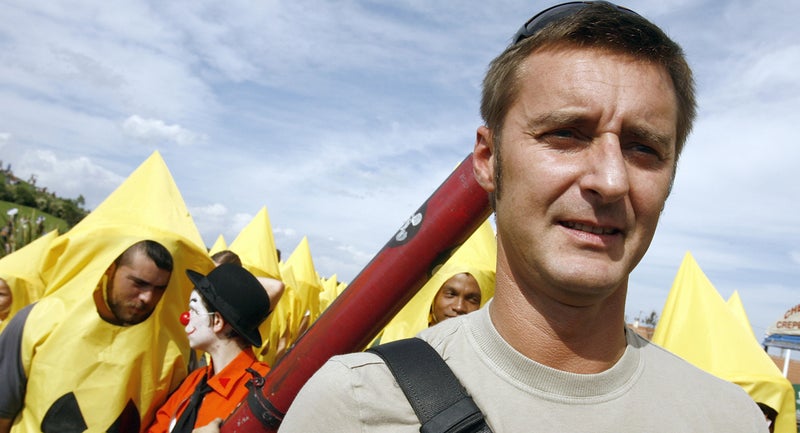
Still, the master plan has created friction. Last summer, the European press, which covers Greenpeace closely, erupted when one of the groupŌĆÖs financial officers speculating on international markets. Then NaidooŌĆÖs second in command, Pascal Husting, was outed for commuting regularly to Amsterdam from his home in Luxembourg by plane. Forty-three members of the Netherlands office called for Husting to resign. Naidoo apologized and Husting kept his job, though .
ŌĆ£This was hugely sensitive,ŌĆØ says , the director of that office. ŌĆ£IŌĆÖm not sure Kumi and Pascal understood the reputation risks in the Netherlands on this.ŌĆØ Borren is a firm supporter of NaidooŌĆÖs changes. ŌĆ£There are still a lot of people who want Greenpeace mostly how it wasŌĆöDavid and Goliath,ŌĆØ she told me. ŌĆ£WeŌĆÖre not in that space anymore. IŌĆÖm not a hippie. WeŌĆÖre a major organization, and we need to get more professional.ŌĆØ
In the aftermath of the Nazca stunt, some observers raised their eyebrows at the notion that GreenpeaceŌĆÖs leaders were ignorant of the plan. ŌĆ£There can be no doubt that Kumi knew of the stunt beforehand,ŌĆØ Paul Watson wrote on Facebook. ŌĆ£And if he did not, he should resign for the incompetence of not knowing that this action would take place.ŌĆØ
There was also plenty of anger within the organization itself. Greenpeace code stipulates that activists take responsibility for their civil disobedience, but the Nazca 20 fled. It looked cowardly. ŌĆ£We donŌĆÖt do that,ŌĆØ said one U.S. staffer; another told me, ŌĆ£I want to know who needs to be told to leave.ŌĆØ
ŌĆ£This activity was completely in violation of Greenpeace values,ŌĆØ Naidoo said. The situation put the organizationŌĆÖs leaders in a bind: normally, Greenpeace takes pride in protecting its activists by paying for legal fees and attracting media attention. Now they were in the sticky situation of condemning the action publicly but refusing to name those responsible out of fear of legal repercussions.
[quote]The Nazca fiasco was raw meat for the large segment of the public that tends to think of environmentalists in generalŌĆöand Greenpeace specificallyŌĆöas strident or out of touch.[/quote]
In December, Greenpeace . Naidoo told me then that it appeared the stunt had been organized by a single person without institutional approval. When he testified in the preliminary hearing in Nazca on December 18, he revealed the organizerŌĆÖs name to Peruvian authorities. ŌĆ£What do you do as a leader?ŌĆØ he had said to me then. ŌĆ£On the one hand, I had to do the right thing in terms of accountability. On the other, I had to take into account that many young people in good faith relied on someone leading the process.ŌĆØ
He didnŌĆÖt tell me the personŌĆÖs name, but judging from early press reports, it wasnŌĆÖt too hard to suspect Sadik. This was confirmed a few weeks later. In January, the First Court of Preliminary Investigation in Nazca ŌĆöbasically an arrest warrantŌĆöfor Mauro Fern├Īndez, a 26-year-old Argentine who had served as spokesman on one of the videos of the stunt. Fern├Īndez, along with the AP and Reuters journalists Abd and Villarraga, were , which can carry a six-year prison term. On January 18, a visibly shaken Fern├Īndez, speaking from his home in Buenos Aires, told a Peruvian news station, ŌĆ£Sadik is the one who evaluates the situation and designs the activity and makes the final decision.ŌĆØ
Two days later, a lawyer for Greenpeace International delivered papers to prosecutors in Nazca. They contained voluntary statements from Fern├Īndez, Sadik, and two other Germans, all of whom described their roles in the action. SadikŌĆöwho, through Greenpeace, declined to speak to ║┌┴Ž│į╣Ž═° after the Nazca actionŌĆönamed himself as the organizer.
Naidoo rejected the idea that Greenpeace was making one person fall on his sword. ŌĆ£From what IŌĆÖm being told,ŌĆØ he said, ŌĆ£the activists didnŌĆÖt know what site they were going to beforehand. So people acted without proper information, and the person holding the information didnŌĆÖt share it. It seems fair that this person should hold responsibility.ŌĆØ
What about the organizationŌĆÖs decentralized structureŌĆödid GreenpeaceŌĆÖs guerrilla strategies open the door for errors in judgment? ŌĆ£ItŌĆÖs not about changing the fundamentals of our approach,ŌĆØ Naidoo said. ŌĆ£This was an objective individual failure rather than an objective institutional failure.ŌĆØ Still, he seemed optimistic that the activists might avoid prison time. He cited precedent: in 2013, followers of the Dakar Rally, an international off-road car race, inflicted significantly more damage to the Nazca Lines and avoided punishment. That same year, with government permission, .
When I spoke with Ana Maria Cogorno, director of the nonprofit Maria Reiche Association, which is dedicated to protecting the lines, she suggested that the government was using Greenpeace to divert attention from its own unwillingness to preserve the site. ŌĆ£They have to blame somebody,ŌĆØ she said. SheŌĆÖs no Greenpeace fan, but she hopes that the attention might finally lead to some protections. ŌĆ£Greenpeace has been such a help to me!ŌĆØ
As of early February, no further charges had been filed. Greenpeace was wrapping up its internal investigation, Sadik was working in the Germany office, and the others were still on the payroll as well. An Argentine judge declined to detain Fern├Īndez but ordered him to stay in the country and remain near his home.
How badly the episode will damage the organization is another question. ŌĆ£The way itŌĆÖs been presented by Greenpeace is that it was a rogue event,ŌĆØ , a member of the Sierra ClubŌĆÖs board of directors, told me. ŌĆ£There are very few groups that have rogue events. And anyplace you have that, it gets shut down and people get fired.ŌĆØ
Both Tercek, the Nature Conservancy CEO, and Sanjayan, of Conservation International, believe Greenpeace can weather this if it learns from its mistake. ŌĆ£I donŌĆÖt think it will hurt them in fundraising,ŌĆØ Sanjayan says. ŌĆ£People who support them understand them. ItŌĆÖs like, ŌĆśYep. Par for the course. ThatŌĆÖs Greenpeace.ŌĆÖ But if Kumi wants to coalesce the organization around a few key points, this does derail that. HeŌĆÖd do well to more strongly articulate what they want, and to build around that, because otherwise the brand is going to get diluted. I mean, think about the word, the name GreenpeaceŌĆöIŌĆÖm not even sure what that means.ŌĆØ
It means different things to different people in different places. In America its activists are seen as treehuggers. In Europe theyŌĆÖre keepers of a noble flame. In boardrooms theyŌĆÖre threats. In India theyŌĆÖre criminals. And in NaidooŌĆÖs mind theyŌĆÖre just getting started. ŌĆ£The way I see it,ŌĆØ he once told me, ŌĆ£addressing climate change is more important than all the injustices weŌĆÖve fought over time put together. Colonialism, slavery, apartheid, the right to vote. This is about survival. So if it was OK for people like me to be prepared to go to prison and be prepared to get killed, then surely when the very future of the existence of the species of humanity is at risk, then I think we need to be willing to take much higher risks.ŌĆØ
In December, Naidoo hinted to me that plans for more actions were in the works, things that might replace Nazca in the news cycle. But not everything fades. Look at an aerial image of the Nazca hummingbird now and you can clearly make out the giant CŌĆöa big, curving line in the sand. It will probably be around for a while.
Contributing editor Abe Streep () wrote about shark catcher Chris Fischer in February.

